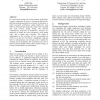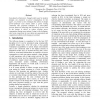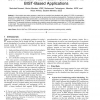74 search results - page 2 / 15 » Controlling Peak Power During Scan Testing |
ITC
2003
IEEE
14 years 3 months ago
2003
IEEE
In a scan-based system with a large number of flip-flops, a major component of power is consumed during scanshift and clocking operation in test mode. In this paper, a novel scan-...
DATE
2010
IEEE
14 years 6 days ago
2010
IEEE
Various X-filling methods have been proposed for reducing the shift and/or capture power in scan testing. The main drawback of these methods is that X-filling for low power leads t...
ITC
2003
IEEE
14 years 3 months ago
2003
IEEE
Scan-based architectures, though widely used in modern designs, are expensive in power consumption. In this paper, we present a new technique that allows to design power-optimized...
TC
2008
13 years 9 months ago
2008
A low-transition test pattern generator, called the low-transition linear feedback shift register (LT-LFSR), is proposed to reduce the average and peak power of a circuit during te...
MTV
2007
IEEE
14 years 4 months ago
2007
IEEE
Test vector ordering is recognized as a simple and non-intrusive approach to assist test power reduction. Simulation based test vector ordering approach to minimize circuit transit...



